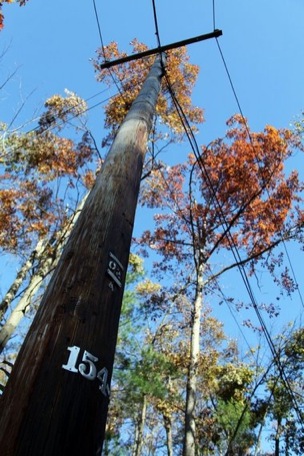
Power lines: To bury, or not to bury -- that's the question
Published: Tuesday, November 22, 2011
By Conor Berry, The Republican

A freshly restored power line in Belchertown, which was among the many Western Massachusetts communities with no power for a prolonged period of time after the October nor'easter. Staff photo by Michael Beswick
For some Western Massachusetts residents, it's only been a little more than two weeks since the lights went back on after a powerful nor'easter killed the juice to nearly 700,000 Bay State utility customers.
Since then, the issue of burying power lines, ostensibly to avoid the sort of widespread outages caused by the unusual autumn snowstorm, has remained an issue as communities explore the idea of saying goodbye to overhead power lines, a staple throughout most New England cities and towns.
Some towns that have investigated the option of "undergrounding" power lines, to use the industry parlance, have concluded what many utility companies already know: It's wicked expensive.
With utility and state officials, including Gov. Deval L. Patrick, citing a $1 trillion price tag to bury lines, the prospect of converting the commonwealth to an underground system is dim, to say the least.
Even so, residents and officials in some Pioneer Valley communities, including Longmeadow and Wilbraham, both of which were hit hard by the Oct. 29 storm, have asked why such a gradual transition couldn't take place. At the very least, they say, it might prevent the sort of week-long power outages that many experienced in the wake of the unusual autumn nor'easter.
A number of Eastern Massachusetts communities, including Concord, Wellesley, Bedford, Duxbury, Nantucket, Holden and Needham, have completed limited projects to bury wires, while others – Chelmsford, North Andover and Westwood – have projects underway .
Brookline Town Engineer Peter Ditto conducted an in-depth study of the underground utility issue several years ago, but town officials ultimately decided against it, according to CBS News in Boston. “Based on the prices at the time, it was anywhere from $45 to $150 million, and the time frame was 75 years,” Ditto told the TV station.
But a closer look at the issue by the Worcester Business Journal Online revealed that the $1 trillion figure cited by Patrick and state Executive Office of Energy and Environmental Affairs Secretary Richard K. Sullivan Jr. could be a bit inflated.
That estimate, the one bandied about liberally by politicians and the media, actually came from Thomas May, the CEO of NStar, during a post-storm meeting.
NStar spokeswoman Caroline Allen emphasized that May's figure was “not a formal estimate,” but rather intended to “demonstrate the complexity involved in building an underground system,” according to a WBJ story titled "Behind The Sound Bite: Burying Power Lines."
Allen said arriving at a more accurate estimate would be impossible "without a complete engineering review of the entire state." Her boss, she said, was merely "pointing out that it would be astronomically expensive" for NStar to bury all of its lines.
Even with some doubt about the overall price of converting Massachusetts to an underground transmission, many utility officials claim installing wires beneath the ground is just too cost-prohibitive.
Western Massachusetts Electric Co. spokeswoman Sandra Ahearn told abc40, media partner of The Republican and MassLive.com, that it costs about $600,000 per mile to build an overhead system and "up to ten times that amount to bury it."
"Underground systems perform very well early in their life," she told the TV station. "As they age, the repair process additionally becomes more complicated, so there's no real panacea to this."
Daniel Howard, general manager of Westfield Gas & Electric, echoed similar statistics, according to abc40.
Patrick told Statehouse News Service that he "love(s) the idea" of burying power lines, but he also noted that no one has identified a way to foot the bill.
The Edison Electric Institute, a Washington-based association of shareholder-owned electric companies, concluded in a 2009 report, "Out of Sight, Out of Mind Revisited: An Updated Study on the Undergrounding Of Overhead Power Lines," that "the most significant obstacle" to converting above-ground systems to underground systems is the cost — at five to 10 times the price tag of overhead lines.
Conversion costs for distribution lines range from $80,000 per mile in rural areas to $2.1 million in urban areas, according to an analysis by WBJ online. For transmission lines, it would be even more.
Using the high end of those price estimates, it would cost Massachusetts, with 29,080 miles of distribution lines and roughly 1,700 miles of overhead transmission lines, around $99.1 billion to bury all power lines – more than 10 times less than the $1 trillion figure widely cited in the wake of the October storm, according to WBJ.
However, a statewide undergrounding initiative would be an expensive, multidecade effort.
